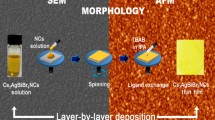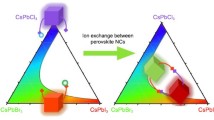Abstract
Cesium-based lead-free perovskites are promising alternatives to the organic–inorganic lead perovskites due to lead toxicity and moisture/oxygen sensitivity of the latter. Perovskites can be synthesized in the form of single perovskite structures having the general formula (ABX3) as well as double perovskite structures with the formula (A2BIBIIIX6). Double perovskites structures have several advantages over single perovskite structures in terms of phase stability. Ag and Bi-based Cs halide double perovskites (Cs2AgBiX6) are significantly promising among different double perovskite structures. The theoretical predictions have shown that the Cs2AgBiI6 has the most suitable optoelectronic characteristics among their bromide and chloride counterparts. Experimentally, the synthesis of Cs2AgBiI6 is challenging due to the formation of thermodynamically more stable Cs2Bi2I9. On the other hand, Cs2AgBiBr6 is a stable composition, but it is undesirable in solar cell applications due to its larger bandgap. In the present work, we report the facile synthesis and characterization of stable mixed halide Cs2AgBiX6 (X = Br, I) nanocrystals which show better stability than Cs2AgBiI6 and have smaller band gap in comparison with that of Cs2AgBiBr6.
Access provided by Autonomous University of Puebla. Download conference paper PDF
Similar content being viewed by others
Keywords
1 Introduction
Lead (Pb) halide perovskites, with the generic chemical formula ABX3, have received a lot of attention from both the scientific and industrial communities. Here, A is a CH3NH3+ (MA+), CH(NH2)2+ (FA+), or Cs+ cation, B is a Pb2+ cation, and X is a Cl−, Br−, or I− anion [1, 2].The remarkable 3D perovskite structure that includes a ns2 electronic structure at the outermost orbital and higher-quality charge carrier characteristics such as better carrier mobility and relaxed carrier without traps, accounts for the excellent optical features of the lead-based perovskite NCs. However, Pb toxicity is frequently seen as a drawback, which motivates researchers to identify alternative substitutes. Recently, lead-free perovskite NCs have been reported by using non-hazardous metal ions in place of Pb2+ in the perovskite structures [3]. The 3D double perovskites ABIBIIIX6 (A: Cs, CH3NH3; BI: Ag, Au; BIII: Bi, In; X: Cl, Br, I) have been shown to be synthesized by substitution of one monovalent B+ and one trivalent B3+ cation for the Pb2+ cation. Lead-free double perovskites exhibit attractive optical and electrical characteristics, such Cs2AgBiBr6 [4]. The key factor limiting Cs2AgBiBr6 photovoltaic performance is its large band gap. On the other hand, Cs2AgBiIr6 shows suitable bandgap but lacks stability [4]. It is highly desirable to develop effective approaches to synthesize the stable lead-free double perovskite compositions having suitable bandgap for solar cell applications. In this direction, several efforts have been made to modify the structure and to improve the photovoltaic characteristics. For instance, the bandgap of Cs2AgBiBr6 has been successfully reduced from 2.12 to 1.86 eV via Sb impurity doping which has been attributed to the upshifting of valence band maximum resulting in the narrowing of bandgap due to higher energy levels of Sb 5 s states when compared with those of 6 s states [5, 6]. Synthesis of mixed halide compositions is another strategy which can be used to obtain stable Pb-free double perovskite compositions by suitably optimizing the ratio of halide ions in the compositions [5,6,7]. Traditionally, mixed halide compositions are synthesized using ion exchange method which is a complex multistep method not suitable for bulk synthesis [6, 7]. Herein, we report the facile one step synthesis and characterization of mixed halide (I/Br) double perovskite (Cs2AgBiX6: X = Br, I) nanocrystals.
2 Materials and Methods
2.1 Materials
All the chemicals used in the synthesis process, namely Cs2CO3 (99% purity cesium carbonate), AgBr (99% purity silver(I) bromide), BiI3 (99% purity bismuth(III) iodide), mineral oil (light), oleic acid (90%, technical grade), oleylamine (70%, technical grade), and hexane (≥ 97.0% purity HPLC grade, GC), were procured from Thermo-Fisher Scientific and handled without going through extra purifying procedures.
2.2 Facile Synthesis of Mixed Halide Double Perovskite Nanocrystals (DPNCs)
The production of double perovskite nanocrystals (DPNCs) was made possible by the use of a facile synthesis approach. For the synthesis of Cs2AgBiX6 (X = Br, I), mixed halide DPNCs 0.1 mmol of Cs2CO3, 0.1 mmol of AgBr, and 0.4/0.5 mmol (for two different compositions) of BiI3 were mixed with 500 µL of oleic acid, 500 µL of oleyl amine and 10 ml of mineral oil and subjected to using probe sonication at the power of 60-W for 12 min until the initially colorless solution turned into red colored. At this stage the reaction flask was rapidly cooled down in an ice bath. The as-synthesized crude solution was centrifuged at 8000 rpm for 10 min to eliminate the impurities, followed by redispersion of the precipitates in 5 ml of hexane using mild sonication. Further centrifugation at 2000 rpm was used to eliminate any large crystals resulting and to achieve supernatant having well dispersed double perovskite nanocrystals.
2.3 Characterization
To study the structural and optical properties of the as-synthesized double perovskite nanocrystals (DPNCs), various characterization techniques were employed. The morphology of the DPNCs was analyzed using TEM (Technai, F30 S-Twin). The x-ray diffraction pattern of the DNCs thin film was obtained at room temperature using x-ray diffractometer (Rigaku Smart-Lab). Optical absorption and photoluminescence studies of DPNCs were conducted using UV–visible spectroscopy (Perkin Elmer-Lambda 365+) and photoluminescence spectrophotometry (Shimadzu-RF-5301PC), respectively.
3 Results and Discussion
Figure 1a depicts a typical low magnification TEM image of pure double perovskite nanocrystals (DPNCs). It shows a narrow size distribution within the range of 15–30 nm. The well-dispersed DPNCs without any indication of aggregation are clearly apparent in the high magnification TEM image (Fig. 1b).
X-ray diffraction pattern of as-synthesized mixed halide double perovskite nanocrystal sample are shown in Fig. 2. In this double perovskite structure AgBr(I)6, BiBr(I)6 octahedrons are alternatively connected by sharing bridged Br−(I−) ions. The XRD pattern of Cs2AgBiX6 (X = Br, I) depicts the peaks located at 2θ values of 29.24°, 33.92°, 35.26°, 40.94°, 47.82°, 50.38°, 53.06°, and 58.52°, which can be indexed to (400), (420), (422), (440), (620), (622), (640), and (642) planes, respectively [7]. All the members of the compositional family Cs2AgBiX6 show XRD peak positions very close to each other. However, these peak positions shift toward lower 2-theta values when one moves from Cl− containing compositions to I− containing compositions due to increase in the size of halogen ions [8]. For instance, diffraction peak corresponding to (400) plane of Cs2AgBiBr6 occurs at 31.14°, while for Cs2AgBiI6 it occurs at 29.15° [7]. In the present structure XRD peak for (400) plane appears at 29.24°, which is a clear indication of the successful synthesis of mixed halide Cs2AgBiX6 nanocrystals containing I− and Br− ions.
Figure 3a shows the UV–vis absorption spectra of as-synthesized Cs2AgBiX6 nanocrystals having different I− content. With the increase in the amount of iodine ions, the UV–vis absorption spectra of double perovskite nanocrystal structure bathochromically shifts from 464 to 490 nm (Fig. 3a) and the optical bandgap is reduced from 2.36 to 2.16 eV. The decrease in optical bandgap on the increase in iodine ions may be due to smaller gap between the bonding and antibonding states of Pb2+–I− hybridized orbitals in comparison with that of Pb2+–Br− hybridized orbitals [7, 8].
PL spectra have been used to evaluate the effect of increase in the iodine content on the luminescent properties of lead-free mixed halide double perovskite nanocrystals (Fig. 4) which shows that the lead-free mixed halide DPNCs Cs2AgBiX6 (X = Br, I) has relatively broad emission in comparison with the reference material Cs2AgBiX6 NCs. With increase in iodine contents, the PL emission is red shift from 523 to 552 nm. This result is consistent with the results of the UV–visible spectra and can be seen as the result of bandgap narrowing on increase of the iodine content [8].
4 Conclusion
We demonstrated the facile synthesis of lead-free mixed halide DPNCs with enhanced chemical and colloidal stability. The optical bandgap of these DPNCs was found to decrease when compared with that reference Cs2AgBiX6 NCs, which may be due to the introduction of iodine ions in the lattice as confirmed by UV–vis absorption spectra. PL emission spectra showed red-shifted broad emission. We believe that the protocols used in this work may further be extended to other double perovskite compositions to achieve higher chemical stability toward the development of high performing lead hazard-free perovskite solar cells.
References
Ahmad S, Abbas H, Khan MB, Nagal V, Hafiz AK, Khan ZH (2021) ZnO for stable and efficient perovskite bulk heterojunction solar cell fabricated under ambient atmosphere. Sol Energy 216:164–170
Abbas H, Ahmad S, Parvaz M, Khan MB, Khan MS, Khan A, Alshahrie A, Khan ZH (2022) Surface optimization of metal halide perovskite solar cells using ZnS nanorods. J Mater Sci Mater Electr 33(27):21576–21587
Abbas H, Khan MS, Ahmad S, Parvaz M, Khan MB, Khan A, Alshahrie A, Khan ZH (2022) Reduction of extrinsic defects in ZnSe: perovskite composites based solar devices. J Nanopart Res 24(12):270
Dave K, Fang MH, Bao Z, Fu HT, Liu RS (2020) recent developments in lead-free double Perovskites: structure, doping, and applications. Chem Asian J 15(2):242–252
Lei L-Z, Shi Z-F, Li Y, Ma Z-Z, Zhang F, Xu T-T, Tian Y-T, Wu D, Li X-J, Du G-T (2018) High-efficiency and air-stable photodetectors based on lead-free double perovskite Cs2AgBiBr6 thin films. J Mater Chem C 6(30):7982–7988
Ji F, Klarbring J, Wang F, Ning W, Wang L, Yin C, Figueroa JSM et al (2020) Lead-free halide double Perovskite Cs2AgBiBr 6 with decreased band gap. Angew Chem 132(35):15303–15306
Wu H et al (2021) Mixed-halide double Perovskite Cs2AgBiX6 (X= Br, I) with tunable optical properties via anion exchange. Chemsuschem 14(20):4507–4515
Zhang Y et al (2019) Surface science and colloidal stability of double-perovskite Cs2AgBiBr 6 nanocrystals and their superlattices. Chem Mater 31(19):7962–7969
Acknowledgements
One of the authors (Mohd. Bilal Khan) expresses gratitude toward CSIR, Govt. of India for their support in the form of a Research Associateship (File No. 09/0466(11082)/2021-EMR-I).
Author information
Authors and Affiliations
Corresponding author
Editor information
Editors and Affiliations
Ethics declarations
Conflict of Interest
The authors declare that they have no conflict of interest.
Rights and permissions
Copyright information
© 2023 The Author(s), under exclusive license to Springer Nature Singapore Pte Ltd.
About this paper
Cite this paper
Khan, M.S. et al. (2023). Facile Synthesis of Lead-Free Mixed Halide Double Perovskite Cs2AgBiX6 (X = Br, I) Nanocrystals (NCs) for Photovoltaics Applications. In: Khan, Z.H., Jackson, M., Salah, N.A. (eds) Recent Advances in Nanotechnology. ICNOC 2022. Springer Proceedings in Materials, vol 28. Springer, Singapore. https://doi.org/10.1007/978-981-99-4685-3_82
Download citation
DOI: https://doi.org/10.1007/978-981-99-4685-3_82
Published:
Publisher Name: Springer, Singapore
Print ISBN: 978-981-99-4684-6
Online ISBN: 978-981-99-4685-3
eBook Packages: Chemistry and Materials ScienceChemistry and Material Science (R0)








